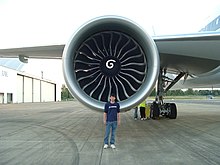Longer-range models
On February 29, 2000, Boeing launched its next-generation twinjet program,[77] initially called 777-X,[72] and began issuing offers to airlines.[65]Development of the long-range models was slowed by the airline industry downturn, which lasted through the early 2000s.[67] The first model to emerge from the program, the 777-300ER, was launched with an order for ten aircraft from Air France,[78] along with additional commitments.[65] On February 24, 2003, the −300ER made its first flight, and the FAA and EASA (European Aviation Safety Agency, successor to the JAA) certified the model on March 16, 2004.[79] The first delivery to Air France took place on April 29, 2004.[67] The −300ER, which combined the −300's added capacity with the −200ER's range, became the top-selling 777 variant in the late 2000s,[80] gaining orders as airlines replaced comparable four-engine models with twinjets because of their lower operating costs.[81]
The second long-range model to be developed, the 777-200LR, rolled out on February 15, 2005, and completed its first flight on March 8, 2005.[67] The −200LR was certified by both the FAA and EASA on February 2, 2006,[82] and the first delivery to Pakistan International Airlines occurred on February 26, 2006.[83] On November 10, 2005, the first −200LR set a record for the longest non-stop flight of a passenger airliner by flying 11,664 nautical miles (21,602 km)[7] eastward from Hong Kong to London.[6] Lasting 22 hours and 42 minutes, the flight surpassed the −200LR's standard design range and was logged into the Guinness World Records.[6][84]
The production freighter model, the 777F, rolled out on May 23, 2008.[85] The maiden flight of the 777F, which used the structural design and engine specifications of the −200LR[86] along with fuel tanks derived from the −300ER,[87] occurred on July 14, 2008.[88] FAA and EASA type certification for the freighter was received on February 6, 2009,[89] and the first delivery to launch customer Air France took place on February 19, 2009.[90][91]








0 komentar:
Posting Komentar